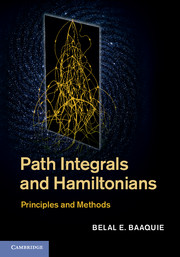Book contents
- Frontmatter
- Dedication
- Contents
- Preface
- Acknowledgements
- 1 Synopsis
- Part one Fundamental principles
- Part two Stochastic processes
- Part three discrete degrees of freedom
- 8 Ising model
- 9 Ising model: magnetic field
- 10 Fermions
- Part four Quadratic path integrals
- Part five Action with acceleration
- Part six Nonlinear path integrals
- References
- Index
8 - Ising model
from Part three - discrete degrees of freedom
Published online by Cambridge University Press: 05 April 2014
- Frontmatter
- Dedication
- Contents
- Preface
- Acknowledgements
- 1 Synopsis
- Part one Fundamental principles
- Part two Stochastic processes
- Part three discrete degrees of freedom
- 8 Ising model
- 9 Ising model: magnetic field
- 10 Fermions
- Part four Quadratic path integrals
- Part five Action with acceleration
- Part six Nonlinear path integrals
- References
- Index
Summary
The simplest possible quantum degree of freedom has only two discrete possible values and is called an Ising spin. This could be a spin system having only two possible values, namely “up” or “down,” or this could be a quantum particle that can occupy only two possible positions.
To simplify the problem to its bare essentials, a two-state system is studied in zero-dimension space and in Euclidean time; the two-state system occupies a single point and, as it evolves in time, it can point either up or down. Furthermore, time evolution is simplified by discretizing time into a finite time lattice.
The two-state degree of freedom in zero-dimension space propagating on a time lattice is called the Ising model. The one-dimensional Ising model is a toy model that is studied to develop the essential ideas of quantum mechanics. The concepts of state space, Hamiltonian, evolution kernel, and path integration have a discrete and simple representation in the Ising model.
The Ising model can be viewed as a statistical mechanical system in thermal equilibrium, with the Ising spins occupying a one-dimensional space lattice, and hence is called the one-dimensional Ising model. The Ising model can be defined on higher dimensional lattices and forms one of the bedrocks of theoretical statistical mechanics.
In Sections 8.1 to 8.5 the degree of freedom, state space, Hamiltonian, path integral and correlator for the Ising model are discussed. In Section 8.6, the technique of spin decimation is illustrated using an Ising model with coupling depending on the lattice site.
- Type
- Chapter
- Information
- Path Integrals and HamiltoniansPrinciples and Methods, pp. 161 - 179Publisher: Cambridge University PressPrint publication year: 2014



